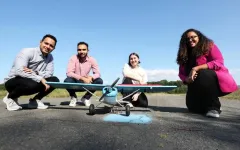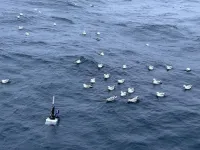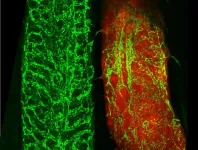(Press-News.org) RICHLAND, Wash.—Scientists are gathering at the Department of Energy’s Pacific Northwest National Laboratory this week for a first-ever conference to consider ways to protect critical systems such as our electrical grid, water treatment plants and financial networks that are vulnerable in new ways.
The Cyber Supply Chain Risk Management Conference, known as CySCRM 2024, is being held on the PNNL campus Tuesday-Wednesday, Oct. 29-30.
It’s a new kind of science meeting, one that scientist Jess Smith and colleagues felt compelled to create as they eye a new kind of risk—a world where billions of lines of computer code are intertwined with critical physical systems whose electronic components come from suppliers across the globe. The combination of a connected world and a complex supply chain creates opportunities—and vulnerabilities.
“It used to be that physical systems, such as the devices that open valves or turn on or off transformers, were distinct from traditional computer systems. That is no longer the case,” said Smith. “There is no longer a line between these functions, and anything that is digital could be vulnerable to being hacked. We need to be vigilant about every single device in these incredibly complex networks.”
Imagine a new car which typically has more than 1,000 computer chips embedded within, managing everything from fuel efficiency to a smooth ride. Understanding the supply chain, reliability and manufacturing history of every part of the car, including those computer chips and the software that runs them, is a massive challenge.
Now consider the U.S. electrical grid with its millions of components, assembled and maintained by more than 40,000 partners who work cooperatively to keep the electricity humming. Not only the chips but also the software come from all over the world, with source codes created by thousands of developers embedded into the larger codes that run the system.
Tracking the fidelity of code from thousands of developers is challenging. But even the opposite is a problem: If there is a limited number of suppliers, just one hack can affect many different products, resulting in trouble for millions of people.
In both cases, keeping track of the reliability and authenticity of such codes, of the supply chain behind the software—what officials refer to as “software bill of materials” or SBOM—is a major focus for security experts.
The conference will focus not just on the grid but on other critical systems that span the physical and digital worlds, such as water treatment plants, food producers, and scientific research.
Scientists at Lawrence Livermore National Laboratory and the University of Texas at El Paso are also organizing the conference, with support from NetRise, a company whose focus is on supply chain detection and response. Officials from academia, industry, government and national laboratories are attending. A conference hosted by Livermore is already planned for next year.
In addition to Smith, organizers of the conference at PNNL include Lisa Campbell, Animesh Pattanayak and Rebecca Redeker.
# # #
END
Newly available blood tests to screen for colorectal cancer sound far more appealing than a standard colonoscopy. Instead of clearing your bowels and undergoing an invasive procedure, the tests require only a simple blood draw. But are the tests effective?
A study led by researchers at Stanford Medicine concluded that the new tests are ideal for people who shy away from other colorectal cancer screening. However, if too many people who would have undergone colonoscopies or stool-based tests switch to the blood tests, colorectal cancer death rates will rise. Because the more established colonoscopies and stool tests ...
Embargoed for release until 5:00 p.m. ET on Monday 28 October 2024
@Annalsofim
Below please find summaries of new articles that will be published in the next issue of Annals of Internal Medicine. The summaries are not intended to substitute for the full articles as a source of information. This information is under strict embargo and by taking it into possession, media representatives are committing to the terms of the embargo not only on their own behalf, but also on behalf of the organization they represent. ...
Derek Urwin has a special stake in his work as a cancer control researcher. After undergraduate studies in applied mathematics at UCLA, he became a firefighter. His inspiration to launch a second career as a scientist was the loss of his brother, Isaac, who died of leukemia at only 33 despite no history of cancer in their family. Working with Anastassia Alexandrova, a professor of chemistry and biochemistry in the UCLA College, he earned his doctorate.
Urwin is now a UCLA adjunct professor of chemistry — and still a full-time firefighter with the Los Angeles County Fire Department. In a recent publication, his science shed new light on the chemical underpinnings of exposures ...
PHILADELPHIA (October 28, 2024) – The University of Pennsylvania School of Nursing (Penn Nursing) has been awarded a $3.2 million, 5-year grant from the National Institute of Nursing Research (NINR) to scale out an evidence-based secure firearm storage intervention at Children’s Hospital of Philadelphia (CHOP). Firearms are now the leading cause of death for U.S. children and teens, driving the largest spike in children’s mortality in more than 50 years. The study aims to keep children safer from firearm injury and mortality by promoting secure firearm storage.
The intervention, ...
Taking inspiration from bird feathers, Princeton engineers have found that adding rows of flaps to a remote-controlled aircraft’s wings improves flight performance and helps prevent stalling, a condition that can jeopardize a plane’s ability to stay aloft.
“These flaps can both help the plane avoid stall and make it easier to regain control when stall does occur,” said Aimy Wissa, assistant professor of mechanical and aerospace engineering and principal investigator of the study, published in the Proceedings ...
Marine phytoplankton are fundamental to Earth’s ecology and biogeochemistry. Our understanding of the large-scale dynamics of phytoplankton biomass has greatly benefited from, and is largely based on, satellite ocean color observations from which chlorophyll-a (Chla), a commonly used proxy for carbon biomass, can be estimated. However, ocean color satellites only measure a small portion of the surface ocean, meaning that subsurface phytoplankton biomass is not directly monitored. Chla is also an imperfect ...
Images
There's a famous piece of advice from hockey, attributed to Wayne Gretzky, about how it's better to skate to where the puck is headed rather than where it is.
Research is now showing that regulations designed to protect Lake Erie's water quality are heeding the Great One's words when it comes to safeguarding the Great Lake's fisheries.
Specifically, the currently recommended limits on the flow of nutrients into Lake Erie from agriculture may be too restrictive for some species of fish. They are, however, suited to maintain healthy fisheries until the ...
201.6 million years ago, one of the Earth's five great mass extinctions took place, when three-quarters of all living species suddenly disappeared. The wipeout coincided with massive volcanic eruptions that split apart Pangaea, a giant continent then comprising almost all the planet's land. Millions of cubic miles of lava erupted over some 600,000 years, separating what are now the Americas, Europe and North Africa. It marked the end of the Triassic period and the beginning of the Jurassic, the period when dinosaurs arose to take the place of Triassic creatures and dominate the planet.
The exact mechanisms of the End Triassic Extinction have long been debated, ...
“We found that 30 percent of the regions with available data have fully decoupled carbon emissions from economic growth. Regions with high incomes and a history of carbon-intensive industries, as well as those with significant shares of service and manufacturing sectors were particularly successful in reducing carbon emissions while still experiencing economic growth,“ says Anders Levermann, co-author and head of the research department “Complexity Science” at PIK. “A stabilization of the global mean temperature is only possible with net-zero carbon emissions. That ...
A landmark study led by WEHI and La Trobe University has found a potential new diagnostic marker that could be used to better detect the level of tissue damage in our bodies.
Extracellular vesicles (EVs) are small ‘delivery trucks’ released by our cells that deliver important materials to other cells to aid cellular communication. This study revealed, for the first time, a link between levels of EVs in the blood and tissue damage caused by diseases such as leukaemia.
Researchers hope to leverage the ...





